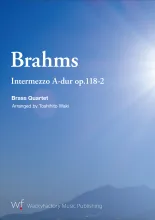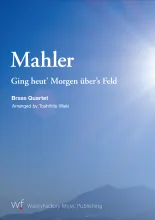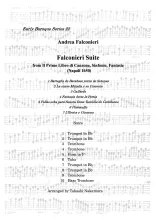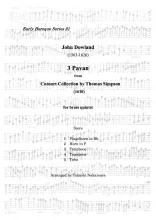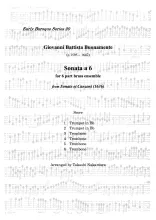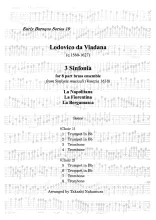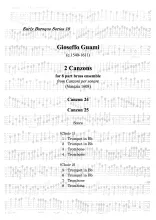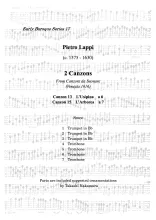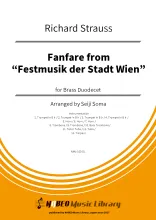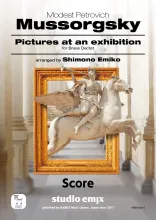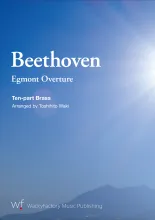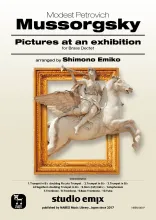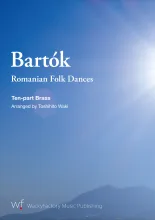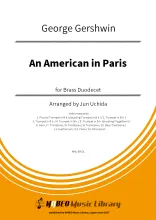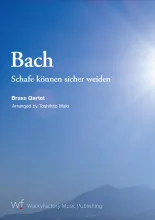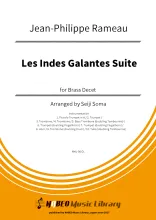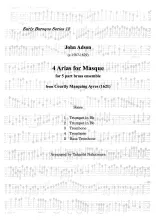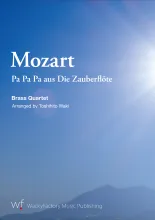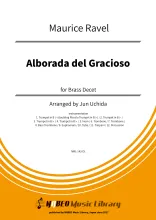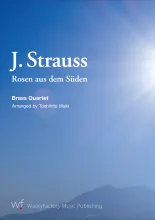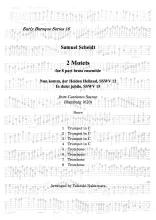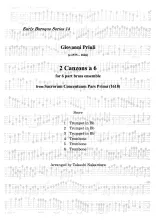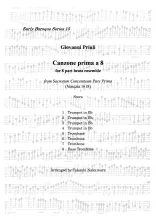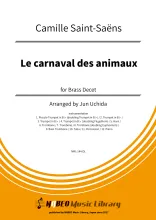New Releases
Our Staff Picks
News
Intermezzo A-dur Op.118-2
BRAHMS, Johannes (arr. WAKI, Toshihito)ヨハネス・ブラームス(arr. 和氣愛仁)
An arrangement for brass quartet of Brahms's late piano solo piece. This is a masterpiece that strikes a chord with its deep and sorrowful feeling.
ブラームス晩年のピアノ独奏曲を金管四重奏用に編曲しました。しみじみとした哀感が心を打つ名曲です。
Ging heut’ Morgen über’s Feld (aus "Lieder eines fahrenden Gesellen")
MAHLER, Gustav (arr. WAKI, Toshihito)グスタフ・マーラー(arr. 和氣愛仁)
The second piece from Mahler's orchestrated song cycle ‘Songs of a Wandering Youth (Lieder eines fahrenden Gesellen)’ arranged for brass quartet. The melody of this piece was later adapted for the First Symphony.
マーラーのオーケストラ付き歌曲集「さすらう若者の歌」から第2曲を金管四重奏用に編曲しました。この曲の旋律は後に交響曲第1番にも転用されています。
Falconieri / Falconieri Suite (Early Baroque Series 22)
FALCONIERI, Andrea (arr. NAKAMURA, Takashi)アンドレア・ファルコニエーリ(arr. 中村孝志)
The following seven pieces has been arranged for ten parts brass ensemble from the instrumental music collection published in 1650 by the Naples composer Andrea Falconieri.
1. Battaglia (Battle of the Devil's Son-in-law Barabaso)
2. La suave Melodia (sweet melody and its courante)
3. Gallarda
4. Fantasia detta la Portia (Fantasia for Portia)
5. Folias (Folia for Mrs. Tarotilla de Caralenos)
6. Passacalle
7. L'Eroica (Hero & Chaccona)
<Tips for performance>
The dynamics, tempo, and articulations are added by the arranger for performance reference. You can freely change it if there are more effective one. (Example: The beginning of the first piece, Battaglia; has each phrase decrescendo, however it can be played with crescendo. Also, this part can be started with forte or piano. It is possible to add the effectiveness of the interaction by making the dynamics of the group and the two groups different.)
イタリアはナポリの作曲家、アンドレア・ファルコニエーリが1650年に出版した器楽曲集から以下の7曲を金管十重奏にアレンジしました。
1. Battaglia(悪魔の娘婿バラバーソの戦い)
2. La suave Melodia(甘いメロディーとそのクーラント)
3. Gallarda(ガイヤルド)
4. Fantasia detta la Portia(ファンタジア ポルティア)
5. Folias(タロティッリャ・デ・カラリェノス夫人のためのフォリア)
6. Passacalle(パッサーカーレ)
7. L'Eroica(英雄&チャッコーナ)
<演奏にあたって>
ダイナミクスやテンポ、アーティキュレーションは編曲者が参考までに付加したものです。これにこだわることなく、自由に演奏効果の高いものに変更して構いません。(例:1曲目、Battagliaの冒頭はそれぞれのフレーズをディクレッシェンドにしていますが、クレッシェンドで演奏しても面白いでしょう。またこの部分はフォルテで始めることもピアノで始めることも可能ですし、1群と2群のダイナミクスを異なるものにして掛け合いの効果を高めることもできるでしょう)
Dowland / 3 Pavan (Early Baroque Series 21)
DOWLAND, John (arr. NAKAMURA, Takashi)ジョン・ダウランド(arr. 中村孝志)
Three pavanes by John Dowland have been arranged for the brass ensemble from the consort music collection (1610) compiled by Thomas Simpson. A quintet of Flugelhorn, horn, two trombones, and tuba. The flugelhorn part has a sample of decoration to be added at second time play. It is not necessary to follow this sample, however please use it as a reference when improvising yourself.
イギリスのトーマス・シンプソンが1610年に編纂した器楽曲集からジョン・ダウランド作のパヴァーヌを3曲、ブラスアンサンブル用にアレンジしました。フリューゲルホルン、ホルン、トロンボーン2本、テューバの変則5重奏の編成です。フリューゲルホルンのパートには繰り返し時に加える装飾のサンプルをつけてあります。必ずしもこの通りに演奏する必要はありませんが自分で即興する際の参考にしてください。
Buonamente / Sonata a 6 (Early Baroque Series 20)
BUONAMENTE, Giovanni Battista (arr. NAKAMURA, Takashi)ジョバンニ・バッティスタ・ブオナメンテ(arr. 中村孝志)
From Giovanni Battista Buonamente's instrumental music collection (published in Venice in 1636), a 6-voice sonata (No.22 in the book) has been arranged into two trumpets and four trombones. This piece begins in Tutti and has an impressive majestic sound. Originally, the top part was supposed to be played with violin (or cornetto), so the overall tonality is lowered fourth in order to fit to trumpets, and the part allocation is modified accordingly.
ジョバンニ・バッティスタ・ブオナメンテの器楽曲集(1636年にヴェネチアで出版)から6声部のソナタ(曲集では第22曲目)をトランペット2本、トロンボーン4本の編成にアレンジしました。テュッティで始まる荘重な響きが印象的な曲です。もともとは最上声部がヴァイオリン(あるいはコルネット)を想定した曲であるため、全体の調性を4度下げ、それに応じてパートの割り振りを修正しています。
Viadana / 3 Sinfonia (Early Baroque Series 19)
VIADANA, Lodovico da (arr. NAKAMURA, Takashi)ロドヴィコ・ヴィアダーナ(arr. 中村孝志)
Arranged three Sinfonia from "Sinfonie musicali" (1610 Venice) by Italian composer Lodovico da Viadana. The three pieces are combined into one, but each can be played independently. Those are a compound choire style in which two groups of four parts, that is popular to Venetian composers such as Giovanni Gabrieli, interact in a dialogue style. La Fiorentina and La Bergamasca are Ostinato bass-style with the same chord progressions, so when the theme comes back, you can add some decorative arrangements to make the performance stand out.
La Napolitana and La Bergamasca, are arranged in full tone down, and La Fiorentina is arranged up to fourth from the original key.
イタリアの作曲家ヴィアダーナの1610年の曲集Sinfonie musicaliから3つの8重奏曲をアレンジしました。3曲を一つにまとめていますが、それぞれ単独の演奏も可能です。いづれの曲もジョバンニ・ガブリエリなどのヴェネチア楽派でおなじみの、4声部から成る2つのグループが対話風に掛け合う複合唱様式となっています。La FiorentinaとLa Bergamascaは同じコード進行が繰り返されるオスティナート・バス形式の曲なので、テーマが戻ってきた時には適度に装飾アレンジを加えると演奏が引き立つでしょう。
La NapolitanaとLa Bergamascaの2曲は原調より全音下げ、La Fiorentinaは4度上げてアレンジしています。
Guami / 2 Canzons a 8 (Early Baroque Series 18)
GUAMI, Gioseffo (arr. NAKAMURA, Takashi)ジョゼッフォ・グアーミ(arr. 中村孝志)
Two eight-voice cansons composed by Gioseffo Guami were selected from the instrumental music collection Canzoni per sonare (36 songs in total) compiled by Alessandro Raverii and published in Venice in 1608. Two groups consisting of two trumpets and two trombones interact with each other, but each first voice has a transcendental passage, which is a highlight. The speed specifications listed are for reference only, but it would be better not to be slower than this tempo.
アレッサンドロ・ラヴェリイ (Alessandro Raverii)が編纂し、1608年にヴェネチアで出版された器楽曲集 Canzoni per sonare (全36曲)の中からジョゼッフォ・グアーミ作曲の8声のカンツォンを2曲取り上げました。トランペット2本トロンボーン2本から成る2つのグループが対話的にかけあいをする形式になっていますが、それぞれの第1声部には超絶技巧的なパッセージがあり、聴かせどころとなっています。記載した速度指定はあくまでも参考テンポですが、なるべくこのテンポより遅くならない方が良いでしょう。
Lappi / 2 Canzons (Early Baroque Series 17)
LAPPI, Pietro (arr. NAKAMURA, Takashi)ピエトロ・ラッピ(arr. 中村孝志)
ピエトロ・ラッピの1616年の器楽曲集からの2曲です。
この時代には即興的な装飾音符がつけられることが当時の演奏習慣でした。特にカデンツ(フレーズの終止)部分では必要不可欠だったようです。この譜面ではそうした装飾の一例をパート譜に小さな音符で加えてあります。必ずしもこの通りに演奏する必要はありませんが、実際の演奏に際しての参考としてみてください。
Scheidt / 2 Motets (Early Baroque Series 16)
SCHEIDT, Samuel (arr. NAKAMURA, Takashi)ザムエル・シャイト(arr. 中村孝志)
Two motets are arranged for 8 part brass ensemble (4 trumpets and 4 trombone) from " Cantiones Sacrae" (Sacred Music) by Samuel Scheidt, which was published 1620 in Hamburg. Among the 38 pieces in the book, the followings are selected here.
No. 12 Nun komm, der Heiden Heiland
No. 15 In dulci jubilo
Both melody was very popular at that time, and many composers other than Samuel Scheidt have made pieces based on those melody.
1620年にハンブルクで出版されたザムエル・シャイトのCantiones Sacrae(全部で38曲の賛美歌が含まれている宗教曲集)の中から以下の2曲を金管8重奏用に編曲しました。
第12曲 Nun komm, der Heiden Heiland 「来たれ、異教徒の救世主」
第15曲 In dulci jubilo 「甘き喜びのうちに」
どちらも当時人気のあったクリスマス用の曲で、シャイトの他にも様々な作曲家がこの旋律を元にした曲を残しています。
Le carnaval des animaux
SAINT-SAËNS, Camille (arr. UCHIDA, Jun)カミーユ・サン=サーンス(arr. 内田淳)
サン=サーンスが私的なコンサートの為に作曲した組曲「動物の謝肉祭」です。他の作曲家のメロディーをパロディーが含まれるため「白鳥」以外は生前に出版されませんでした。金管十重奏に打楽器とピアノを加えた編成になっています。
演奏時間:約26分
